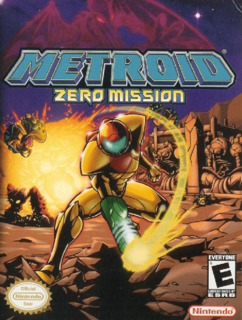Zero Mission is fun while it lasts... Unfortunately, it doesn't last very long.
And what production values they are. The GBA is clearly being pushed to the limits with this game. The sprite based 2D graphics are all highly detailed and filled with color. Samus herself animates in an almost jaw dropping way; despite being 2D, she moves with lifelike believability, and little details like her gun always being on her right arm top off her good looks. The attention to detail in the game is truly staggering. There are tons of little touches that are almost unnoticeable, but the creators felt it fit to put them in anyways. The environments are all pleasing to look at, and they have enough variety so that you never grow tired of them, and you can tell the difference between each one.
Meanwhile, the sound is also top notch. The classic Brinstar theme has been redone so it's much more dramatic and pleasing to hear. Despite the fact that it loops frequently, it doesn't ever grow tiring. The same can be said for the other themes throughout the game. Each area is different, and very well done. You will likely find yourself humming along to the tunes after a while in each place. The sound effects are also quite well done, even though they aren't really as big a part of the game. Explosions, supersonic running, the electrifying sound of the screw attack… they all come through the GBA's speakers quite nicely.
The story, what little there is, is quite interesting. It focuses on Samus's first mission, which is to eradicate all of the mysterious alien creatures known as Metroids on the planet Zebes. There is more to it than that, mostly told through the environment and brief comic book type cutscenes. It's not quite as focused as Fusion's, but it's still well done enough to be interesting.
Of course, the Metroid games have always been about gameplay. And this one, ultimately, is no different. You start out fairly weak; you can only fire simple little beams of energy, can't jump too high, and have a very small amount of health. At first, the places you can go are extremely limited. However, it isn't long before you find the ever present Morph Ball ability, and, from there, you slowly work to become a walking killing machine. The sense of progression, of becoming more powerful and of discovering previously out of reach areas are all here in full force.
While the game is less linear than Metroid Fusion, it still has a set path for you to follow. Scattered around at various points in the many stages you explore are Chozo statues that will show you the general area you need to go. While it may be disappointing to some that the game tells you where you need to go, it's almost never as straightforward as you think at first. There are usually hidden areas, indicated by the "hidden in plain sight" tricks such as a crack in a block or an obviously shown area.
Usually, you will need to find the next big power up so you can progress further into a boss's lair. However, not only do they grant you the ability to progress the story, but new powers typically open up new hidden places to uncover in previously visited areas. For instance, early on, you may come across a block that can only be broken with a Super Missile. Well, you can come back once you've obtained said power up and claim your prize. This encourages exploration, since there are tons of hidden upgrades to find, and you will never find them al on your first run through a level.
The game boasts a few boss battles at the end of certain stages. These are, typically, quite spectacular in that they are screen filling monstrosities. And they all look quite good; little details abound, and the animation is rather stellar, just like Samus. However, only one of these can truly be considered hard… And it's not the last boss. The first few are quite easy; I beat them on my first try. Their patterns are never too tough to figure out, and you can tell when they're close to death since they will get progressively redder and their attacks will come at you faster and hit harder. However, the general pattern never changes, and even the hard boss has a very basic pattern that shouldn't take too long to figure out. Still, you need to be on your toes, because, later in the game, one slip up can mean a huge loss of precious health.
The number of bosses can, in a way, represent the overall feel of the game, which is very fun but disappointingly short. Much like how there are only a handful of boss battles, the game can easily be beaten in five or six hours, and that's if you have no idea what you're doing. To get all the powerups would probably maybe up to three hours' extra playtime (if you really take your time with it). Of course, there's always the extra difficulty to challenge yourself with, or you can try doing speedruns with as few items as possible. Since the game is so short, it does encourage replay. However, it ends very abruptly, and it feels like it should be longer.
Despite the very short length, the game is still worth playing if you love 2D action/ adventure games. It offers the same satisfying mix of run and gun action, exploration and "stranded on an alien planet" atmosphere that made Metroid such a popular series in the first place. The top notch production values, responsive controls and fun combat will keep you coming back. Just beware that the fun doesn't last forever. So long and thanks for reading.

